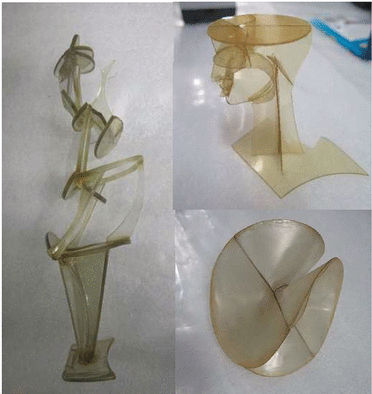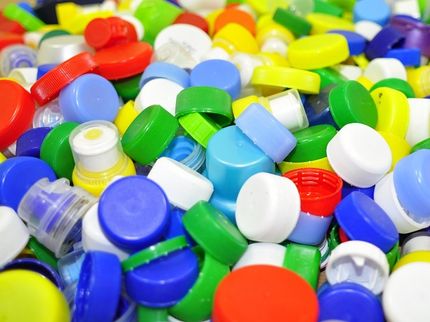What the Smell Can Tell
The degradation status of modern polymeric museum artifacts can be classified by their smell
Breath analysis in disease diagnostics is a promising research field, and the advances in instrumentation allows the accurate detection of metabolites. But not only the health status of patients, but also the preservation status of museum artifacts could be monitored. Heritage science researchers have investigated emissions of volatile organic compounds from plastics-based art objects and provided a first calibration scheme for polymer degradation in museum environment.

© Wiley-VCH
Everyone is familiar with the detection of volatile organic compounds (VOCs). They can be sensed by the nose and tongue, indicating several aspects of the current state of the emitting system—be it the mown grass in the backyard, the level of maturation of cheese or decay in fish, or even if a patient suffers from diabetes. But the emittance of marker chemicals is not restricted to living systems. Volatile degradation products can also be detected for polymers. Since the beginning of the 20th century, many plastics-based objects have found their way into museums, and conservators and heritage scientists are highly interested in assessing their preservation status, ideally without taking physical samples from the objects. Katherine Curran and her colleagues from the University College London (UCL) Institute for Sustainable Heritage, the University of Strathclyde, Glasgow, working in collaboration with several museums, libraries, and archives, now introduce a noninvasive gas-chromatography/mass-spectrometry detection system for marker VOCs emitted by several polymers contained in modern museum artifacts. They also developed a rough calibration system to classify three real objects from the Tate into two distinct decay states.
Every polymer leaves its own signature of degradation products. For example, degrading cellulose acetate emits acetic acid, which can be quantified over time. To assess the quality and quantity of VOCs from polymers, the scientists chose chemical markers for polymers common in museum artifacts such as cellulose-based polymers, polyurethane foam, poly(vinyl chloride), polystyrene, and polyethylene. As reference degradation states, they used modern polymeric samples exposed to heat for zero to 10 weeks. The aim was to find characteristic VOC patterns: “The VOCs detected provide an insight into the composition and ongoing chemical degradation processes of the objects studied,” the authors remarked.
Based on the detected VOCs, a rough classification scheme as “early stage” and “advanced degradation state” could be established for the different polymers—and tested for real museum objects based on these materials. For two cellulose-based objects from the Tate made in the 1920s and 1930s, the scientists reported a low degradation state, but one made in 1923–1924 was found in a more advanced decay. While this might be a matter of concern for the conservators, Curran and her colleagues think of expanding their analysis: A calibration scheme based on naturally aged samples would help reduce the current limitations, they argue.
Original publication
Other news from the department science
These products might interest you

Eclipse by Wyatt Technology
FFF-MALS system for separation and characterization of macromolecules and nanoparticles
The latest and most innovative FFF system designed for highest usability, robustness and data quality

HYPERION II by Bruker
FT-IR and IR laser imaging (QCL) microscope for research and development
Analyze macroscopic samples with microscopic resolution (5 µm) in seconds

Get the chemical industry in your inbox
By submitting this form you agree that LUMITOS AG will send you the newsletter(s) selected above by email. Your data will not be passed on to third parties. Your data will be stored and processed in accordance with our data protection regulations. LUMITOS may contact you by email for the purpose of advertising or market and opinion surveys. You can revoke your consent at any time without giving reasons to LUMITOS AG, Ernst-Augustin-Str. 2, 12489 Berlin, Germany or by e-mail at revoke@lumitos.com with effect for the future. In addition, each email contains a link to unsubscribe from the corresponding newsletter.
Most read news
More news from our other portals
See the theme worlds for related content
Topic world Gas chromatography
Gas chromatography is an essential method in analytical chemistry for the separation and analysis of volatile compounds. Due to its high resolution and sensitivity, it has become firmly established in areas such as environmental analysis, food chemistry or forensic science. GC provides precise and reliable results and enables deep insights into the chemical composition of samples.

Topic world Gas chromatography
Gas chromatography is an essential method in analytical chemistry for the separation and analysis of volatile compounds. Due to its high resolution and sensitivity, it has become firmly established in areas such as environmental analysis, food chemistry or forensic science. GC provides precise and reliable results and enables deep insights into the chemical composition of samples.
Topic World Mass Spectrometry
Mass spectrometry enables us to detect and identify molecules and reveal their structure. Whether in chemistry, biochemistry or forensics - mass spectrometry opens up unexpected insights into the composition of our world. Immerse yourself in the fascinating world of mass spectrometry!

Topic World Mass Spectrometry
Mass spectrometry enables us to detect and identify molecules and reveal their structure. Whether in chemistry, biochemistry or forensics - mass spectrometry opens up unexpected insights into the composition of our world. Immerse yourself in the fascinating world of mass spectrometry!


























































